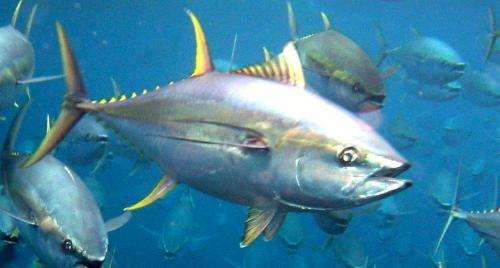Early-warning system to prevent fishery collapse discovered

Threats from overfishing can be detected early enough to save fisheries— and livelihoods —with minimal adjustments in harvesting practices, a new study by researchers in the University of Minnesota's College of Biological Sciences shows.
The work indicates that a healthy fishery can be maintained the way a skillful captain steers an oil tanker: by small course corrections that prevent disaster far ahead.
The study, by Ecology, Evolution and Behavior (EEB) graduate student Matt Burgess and co-advisors Stephen Polasky (EEB and Applied Economics in the College of Food, Agricultural and Natural Resource Sciences) and David Tilman (EEB), was published on September 16 in the the Early Edition of Proceedings of the National Academy of Sciences.
Specifically, the work demonstrates how extinction and overfishing threats from multispecies fisheries can be identified decades before valuable species are over-harvested and populations decline.
Most of the world's large fisheries use nets or lines with multiple hooks, which catch multiple species simultaneously and have serious ecological consequences. Past population declines and current increases in harvest rates can be used to assess current threats of overfishing and extinction, but this approach doesn't apply to future threats. By predicting future threats, the researchers' new method would enable conservation measures to prevent overfishing and extinction.
The "Eventual Threat Index," presented in the study, uses minimal data to identify the conditions that would eventually cause a species to be harvested at an unsustainable rate. The central premise of the Eventual Threat Index is that because multispecies fisheries impact many species with the same effort, the long-term fates of all species can be predicted if the fate of any one species can be predicted. In any multispecies fishery, there are a few 'key' profitable or managed species, which are easy to identify and whose socio-economic importance makes their long-term harvest rate somewhat predictable. Threats to other species are predicted by measuring their harvest rates relative to these key species.
"The data we collect includes estimates of the relative population sizes, catch rates and the growth rates of different fish populations," Burgess says. "This index uses what we know about what tends to happen to economically important fish to predict the fate of other species caught along with them."
The approach was tested on eight Pacific tuna and billfish populations; four of which have been identified recently by conventional methods as in decline and threatened with overfishing. The study found that the severe depletion of all four populations could have been predicted in the 1950s using the Eventual Threat Index. These results demonstrate that species threatened by human harvesting can be identified much earlier, providing time for adjustments in harvesting practices before consequences become severe and fishery closures or other socioeconomically disruptive interventions are required to protect species.
Burgess says the index is easy and inexpensive to use. He hopes fisheries will adopt it soon.
"In many fisheries, managers could calculate this index tomorrow using the description in the paper and data they have already collected," Burgess says.
The study is based on marine fisheries but could be applied to multispecies fisheries in large bodies of fresh water, such as Lake Superior.
More information: "Predicting overfishing and extinction threats in multispecies fisheries," by Matthew G. Burgess, Stephen Polasky, and David Tilman, www.pnas.org/cgi/doi/10.1073/pnas.1314472110
Journal information: Proceedings of the National Academy of Sciences
Provided by University of Minnesota


















